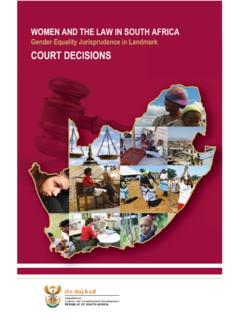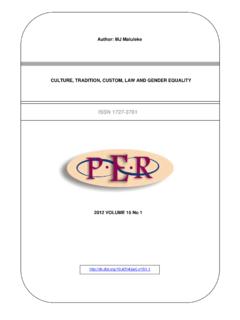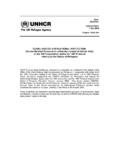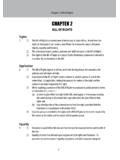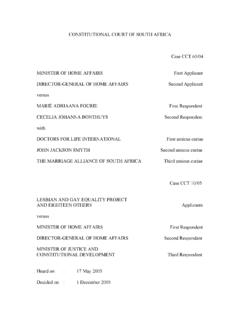Transcription of MENA Gender Equality Profile - Home page | UNICEF
1 QATAR. MENA Gender Equality Profile Status of Girls and Women in the Middle East and North Africa Photo Credits The findings, interpretations and conclusions expressed UNICEF /GAO/2010/Walid Khalil Abu Hamza in this document do not necessarily reflect the policies or views of UNICEF . The designations employed in this publication and the presentation of the material do not imply on the part of the United Nations Children's Fund ( UNICEF ) the expression of any opinion whatsoever concerning the legal status of any country or territory, or of its authorities or the delimitations of its frontiers. 1. 1. Background Demographics Value Year Gender Gap Index 2010. Total population (000) 1,409 2009. Rankings of MENA countries Total adolescent (10-19) population (000) 155 2009 Score Rank with available data Total under-18 population (000) 272 2009.
2 United Arab Emirates 103. Total under-5 population (000) 83 2009. Kuwait 105. Population annual growth rate (%) 2000-2009. Tunisia 107. Total fertility rate (births per woman) 2009. Bahrain 110. Under-five mortality rate 11 2009 Lebanon 116. (per 1000 live births). Life expectancy at birth (years), male 75 2009 Qatar 117. Life expectancy at birth (years), female 77 2009 Algeria 119. Singulate mean age at marriage, male 28 2004 Jordan 120. Singulate mean age at marriage, female 26 2004 Oman 122. Economic indicators Iran (Islamic Republic of) 123. GNI per capita (current US$) - Syrian Arab Republic 124. % share of income held by lowest 20 % 4 2007 Egypt 125. % share of income held by highest 20 % 52 2007 Morocco 127. Saudi Arabia 129.
3 Sources: UNICEF , The State of the World's Children 2011. Life expectancy and economic indicators from The World Yemen 134. Bank, Data Catalog, , [accessed in August 2011]. Marriage data from UNPD, World Marriage Data 2008, Source: World Economic Forum, The Global Gender Gap population/ Report 2010 (rankings of in total 134 countries). 2. Legal Framework Legal system. According to the constitution, Islamic law (Shari'a) is the main source of legislation in In 2006 Qatar introduced a codified family law. The Shari'a courts were abolished in 2003 but Shari'a principles are still applied in matters related to personal status (such as marriage, divorce and child custody). Before a court, in family law matters, a woman's testimony or worth as a witness is not always equal to that of a man.
4 In some cases a woman's testimony is worth half a man's and in some cases a female witness is not accepted at all. A large proportion of Qatar's population is made up of predominantly male foreign guest Only about 225,000. people in Qatar are citizens. Non-citizens do not have the same rights as citizens with regard, for example, to free health care, education and other services, employment opportunities and property Convention on the Elimination of All Forms of Discrimination against Women. Qatar acceded to the Convention on the Elimination of All Forms of Discrimination against Women (CEDAW) in 2009 and maintains reservations against the following articles of the convention: 2 (a) ( Gender Equality in domestic laws and policies), 9 (2) ( Equality with regard to nationality), 15 (1) ( Equality before the law) and 15 (4) (freedom of movement and of residence and domicile), 16 (1) (a), (c) and (f) ( Equality in marriage and family life), as well as 29 (1) (an article related to the administration of the convention; arbitration in the event of a dispute).
5 4 Several of these articles are considered to be at the core of the purpose of the convention. The CEDAW Committee indicated in 1998 that: . reservations to article 16, whether lodged for national, traditional, religious or cultural reasons, are incompatible with the Convention and therefore and that article 2 is central to the purpose and objective of the Qatar has not yet submitted an initial report to the CEDAW Committee. 1 Hauser Global Law School Program, New York University School of Law, GlobaLex, Foreign Law Research, (electronic publication, ) [accessed in August 2011]. 2 Freedom House, Women's Rights in the Middle East and North Africa 2010 (report, online version, ). 3 Department of State, Country Reports on Human Rights Practices, 2011 (report, online version ) [accessed in August 2011].
6 4 See United Nations Treaty Collection ( ) for declarations and reservations made by State Parties 5 Report of the Committee on the Elimination of Discrimination against Women, Eighteenth and Nineteenth Session, A/53/38 , 1998, 2. Convention on the Rights of the Child. Qatar ratified the Convention on the Rights of the Child (CRC) in 1995 with a general reservation on any provisions that are inconsistent with Islamic law. In 2009 Qatar partially withdrew this general reservation and stated that the reservation would continue to apply to articles 2 (non-discrimination) and 14 (freedom of thought and religion). Qatar acceded to the Optional Protocol to the CRC on the sale of children, child prostitution and child pornography in 2001 with a general reservation regarding any provisions that conflict with Shari'a.
7 This reservation was withdrawn in 2008. Qatar is party to the Optional Protocol to the CRC on the involvement of children in armed conflict since 2002, to which it has not made any reservation. Nationality rights. Qatari women married to non-Qatari spouses cannot pass their Qatari citizenship to their children or to their spouse. Qatari fathers on the other hand have the right to pass their citizenship to their children as well as to a foreign spouse after five years of marriage. There is a possibility for foreigners residing in Qatar to apply for citizenship, but only after 25 years of residency in the Divorce rights. A man can divorce his wife for any reason, while women can file for divorce only for certain specified reasons.
8 A woman can also seek divorce without the burden of evidence, in which case she has to give up any financial rights and return her dowry. A rapid separation based on the latter type of divorce is only possible if the husband concedes to the divorce. If he does not agree, it is mandatory that the couple attempt to reconcile. If the reconciliation does not work out, a court may order the Guardianship and custody rights. The father is the legal guardian of the children. Upon divorcing, women may be granted custody of their sons up to the age of 13 and theirs daughters until they turn A mother who has been granted custody has the right to child Inheritance rights. According to Islamic principles, women have the right to inherit, but will generally inherit half the share of their male Freedom of movement.
9 A 2007 law gives Qatari women the right to obtain a passport and travel abroad without the permission of their male guardian. Qatari women still require the permission of their male guardian to obtain a driver's licence. This requirement does not apply to foreign women residing in Protection from child marriage. According to the Family Act, the minimum age of marriage is 18 for boys and 16. for girls. A court may allow a marriage below the minimum age, but it requires the consent of the legal guardian as well as the consent of the two persons to be Polygyny is legal in Protection from Gender -based violence. There is no specific law against domestic violence, but the family law of 2006 states that a woman has the right to be free from physical and mental harm at the hands of her Although rape is a crime, the law does not address the issue of marital rape.
10 The legal system allows lenient sentences to men who commit crimes of honour against 3. Institutions and mechanisms Governmental response. The Supreme Council for Family Affairs (SCFA) is the governmental body responsible for protecting and supporting family affairs, including women's affairs. The SCFA pushed for a codified family 6 Freedom House, Women's Rights in the Middle East and North Africa 2010 (report, online version, ). 7 Ibid. 8 Ibid. 9 Committee on the Rights of the Child, Consideration of Report Submitted by States Parties under Article 44 of the Convention, Second periodic report of Qatar, CRC/C/QAT/2, 2008. 10 Freedom House, Women's Rights in the Middle East and North Africa 2010 (report, online version, ). 11 Ibid.










